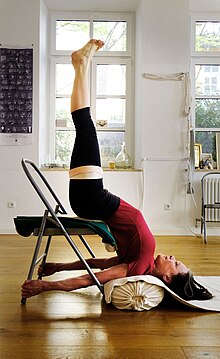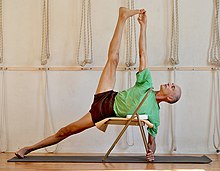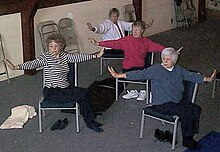Yoga using props
A band or strap of cloth was however used in ancient times, some 2000 years ago, to support the body in one asana in particular; this device was the yogapaṭṭa, a term defined in Monier Monier-Williams's Sanskrit-English dictionary.The other is Nidrāharāsana "Posture to prevent sleep", where a fine balance is maintained with the lower legs crossed in Padmasana and the body upright from the knees (a form of Gorakshasana), and the hands again holding a T-shaped prop.The use of props was pioneered in Iyengar Yoga, to enable students to work with correct alignment both as beginners and in more advanced asanas with suitable support.[11] The scholar of religion Andrea Jain observes that the book "prescribed a thoroughly individualistic system of postural yoga",[12] one that was "rigorous and disciplined",[12] requiring props such as "belts, bricks, and ropes".[14] He comments that highly experienced practitioners can easily miss out on this benefit, feeling that they have no need for props, but that even they may discover in "Butterfly Pose" (the Yin Yoga version of Baddha Konasana) that supporting the knees on blocks allows muscles they did not know they were engaging to relax, transferring the asana's stress to the fascia.Alice Christensen's Easy Does It Yoga, first described in 1979, uses "chair exercises", alongside others on floor or bed, and in later editions also in swimming pools, for older practitioners with restricted movement.[21][22] Lakshmi Voelker-Binder created an approach named Chair Yoga in 1982, on seeing that one of her pupils, aged only in her thirties, was unable to do floor poses because of arthritis.





Sarvangasanayoga mattherapeutic use of yogablockspostural yogamindful yogaYin Yogaarthritismeditation poseB. K. S. Iyengaryoga as exerciseasanasMonier Monier-WilliamsGreat Stupa of SanchiMadhya PradeshMamallapuramElloraSyama JatakaMahabalipuramNarasimhaYoga Sutras of PatanjaliVācaspati'sTattvavaiśāradīVijñānabhikṣuYogavarttikaŚrītattvanidhiNorman SjomanGorkhatriRajasthanSritattvanidhiPātañjalayogaśāstravivaraṇaShankaraHemacandraJames MallinsonKumbh MelaHaridwarYogacintāmaṇīGorakshasanaNidrāharāsanaIyengar YogaUtthita VasisthasanaTirumalai KrishnamacharyaLight on YogaAndrea JainbricksButterflyCyndi Leevinyasa yogaduhkhaahimsaBernie Clarkrestorative yogaSarah PowersBaddha KonasanafasciaVrischikasanaYoga JournalShirshasanaAccessible yogaYoga as therapyexercisemeditationbreath work (pranayama)systematic reviewlow back painaerial yogaRajakapotasanayoga hybridcarabinersList of yoga schoolsYoga pantsSjoman, Norman E.Birch, JasonÉcole française d'Extrême-OrientMallinson, JamesMehta, SilvaDorling KindersleyThe New YorkerJain, AndreaClark, BernieLee, CyndiRiverhead BooksThe Washington PostHarper and RowSkyhorse PublishingFeuerstein, GeorghowstuffworksNew Indian ExpressList of asanasStanding asanasDownward dogLotus positionMeditation seatsSun SalutationTree poseWarriorDrishtiNamastePranayamaVinyāsaHasta VinyasasTeacher trainingBritish Wheel of YogaEuropean Union of YogaAndré Van LysebethYoga AllianceTherapyTrauma-sensitive yogaYoga nidraInternational Association of Yoga Therapists • Richard MillerJanice GatesCompetitive yogaInternational Day of YogaAsana JournalYoga brickAngela FarmerHugger MuggerLululemonEarly modern yogaVivekanandaRaja YogaPierre BernardHarmonial gymnastics/yogaMarguerite AgnielMary Bagot StackGenevieve Stebbins